The Complete Guide to Outsource Software Development for Joget
Date
Jul 04, 25
Reading Time
14 Minutes
Category
Low-Code/No-Code Development
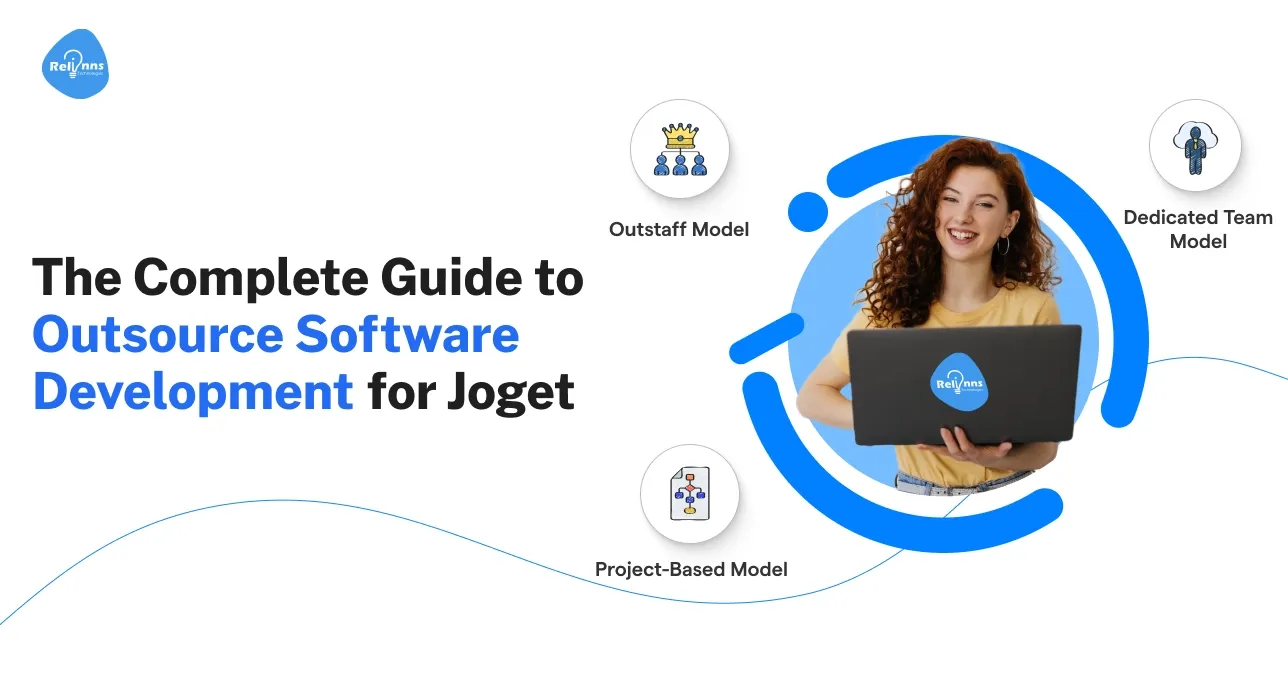
Outsourcing software development has become an important strategic consideration for companies in the ever-increasing demand for faster delivery, cost savings, and specialized skills without managing huge teams in-house.
Global IT outsourcing is on the rise as most companies turn to third parties to cut down on expenses or fill gaps in local technical skills. This trend emphasizes why outsourcing stands at the core of digital transformation strategy today.
This guide will provide detailed information on efficiently outsourcing Joget software development, including models, partner selection, and the best practices that will allow companies to make the programs cost-efficient, scalable, and successful in the long term.
What is outsourced software development?
Outsourced software development is when companies hire external teams to build or manage applications. It reduces costs, speeds delivery, and provides access to specialized skills without expanding in-house teams.
Why do businesses choose outsourced software development?
Businesses often choose to outsource software development for several strategic reasons. While cost reduction was once the primary motive, today companies are equally motivated by access to talent, speed, and flexibility.
According to Deloitte’s global survey, the percentage of companies citing “cost savings” as the primary driver for outsourced development has decreased from 70% a few years ago to 34% today.
In other words, organizations view the decision to outsource software development not only as a means to cut expenses, but also as a strategic tool to enhance their capabilities.
Key reasons companies are embracing software development outsourcing:
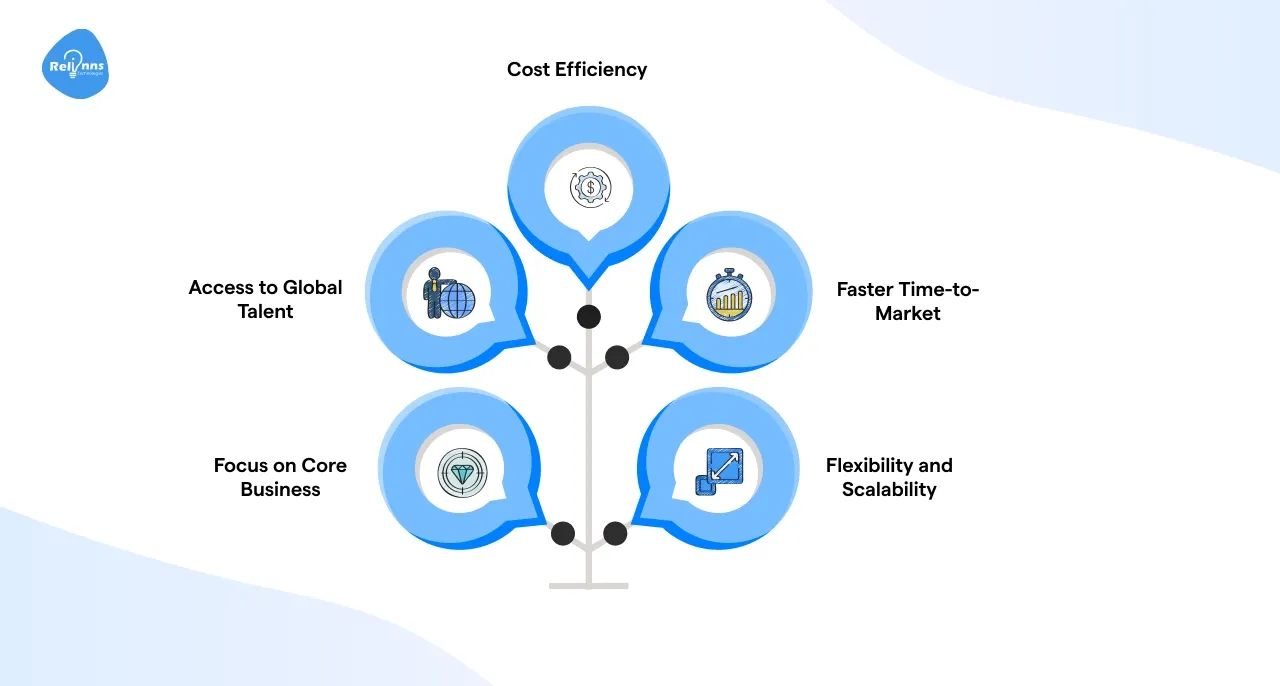
- Cost Efficiency: Outsourcing can significantly reduce development costs by leveraging regions with lower labor rates and minimizing overhead.
- Access to Global Talent: A worldwide tech talent shortage exists, making it challenging to hire specialized experts in-house. When companies outsource development, they tap into a global pool of skilled developers that may not be available locally.
- Faster Time-to-Market: With an external team ready to work, products get to market sooner. Outsourcing vendors often have established workflows and 24/7 development cycles that span multiple time zones.
- Flexibility and Scalability: When you outsource software development, it offers on-demand scaling of your team. You can quickly ramp up developers for a big project or scale down when needs decline, without the delays of recruiting or layoffs.
- Focus on Core Business: By delegating development work to a trusted partner, your in-house team can concentrate on core competencies and strategic initiatives.
These factors explain why we outsource software development and experience a surge in popularity. Now, let’s delve deeper into the specific benefits companies gain by outsourcing the development of their software projects.
What are the benefits of outsourcing software development?
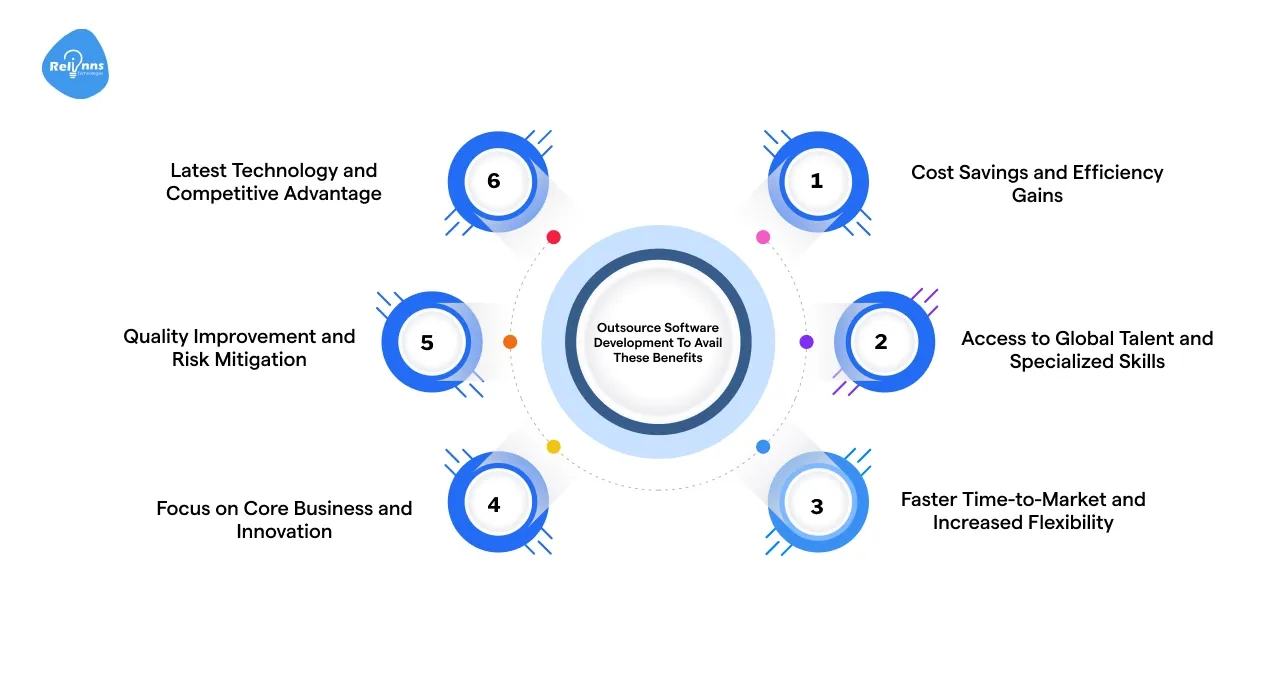
Businesses outsource software development not only to save money, but also to gain capabilities and a competitive advantage.
Below, we break down some of the most significant benefits of software development outsourcing, providing data and examples to illustrate each point.
1. Cost savings and efficiency gains
For many companies, the most immediate benefit of outsourcing development is cost reduction. Hiring, training, and retaining an in-house development team is expensive, especially in countries where outsource software engineers command high salaries.
Flatirons' research indicates companies can reduce development expenses by 60–70% by outsourcing development to external vendors. These savings stem from lower hourly rates in talent-rich countries and from avoiding overhead costs such as benefits, infrastructure, and IT equipment.
Key Highlights:
- Reduces HR, recruitment, and onboarding efforts for internal tech teams.
- Cuts office, equipment, and energy costs tied to in-house staff.
- Enables faster project kickoff with ready-trained expert developers onboard.
- Eliminates training expenses by leveraging pre-skilled external development resources.
- Lowers long-term overhead by streamlining operations and infrastructure costs.
Those savings can be reinvested in other strategic areas, fueling growth. And while cost used to be the only rationale for outsourcing, today it’s just one part of a broader value equation.
2. Access to global talent and specialized skills:
Another significant benefit of software development outsourcing is the unparalleled access to talent it provides. Rather than being limited to local engineers, businesses can tap into expert developers worldwide.
This is vital as the global tech talent shortage is projected to reach 85.2 million unfilled roles by 2030.
With outsource development, companies can instantly plug skill gaps whether for AI, DevOps, or mobile apps. A prior study found that 76% of companies outsource IT functions, such as software development.
Key Highlights:
- Access specialized tech skills not available in your local market.
- Fill urgent gaps without lengthy recruitment or onboarding cycles.
- Hire vetted developers with niche expertise in emerging technologies.
- Gain enterprise-grade talent without committing to full-time hires.
- Scale your project team with proven offshore and nearshore engineers.
This access helps businesses unlock higher-quality results by engaging developers who’ve solved similar problems before.
3. Faster time-to-market and increased flexibility
Speed is essential in today’s fast-moving digital economy. Whether building an MVP or scaling features, delays can result in lost revenue and damage to reputation. With software development outsourcing, you can launch faster and stay competitive.
External teams are ready to begin immediately no waiting for hiring to commence.
Additionally, to outsource software development, firms often operate across multiple time zones, allowing for round-the-clock development. This workflow significantly compresses delivery timelines.
Key Highlights:
- Start development faster without delays from recruitment or onboarding.
- Work across global time zones for near 24-hour project cycles.
- Add developers mid-project to meet aggressive timelines.
- Use vendor agility to pivot when the project needs change.
- Deliver software 40–50% faster than in-house alternatives.
Accelerance reports that if we outsource software development, we can cut launch time by 40–50%. Vendors bring agile processes and reusable components that boost velocity.
You can even ramp up resources mid-project if needed outsource development brings flexibility that internal teams often struggle to match.
4. Focus on core business and innovation
When you outsource software development, your internal team can focus on what matters most innovation, strategy, and growth. Outsource software development frees resources that are otherwise tied up in project management and coding.
Surveys show that the top perceived benefit of outsource development is freeing up internal bandwidth.
According to Clutch, 37% of small businesses outsource to focus on core business areas instead of support functions.
Key Highlights:
- Redirect internal resources toward strategy, research and development, and innovation.
- Reduce management overhead tied to technical team operations.
- Keep your top talent focused on vision, not implementation.
- Delegate bug-fixes and technical delivery to external experts.
- Improve product-market fit through more precise strategic alignment.
CEOs and founders report increased time to drive vision, product planning, and customer engagement.
Meanwhile, external developers handle execution, bugs, and iteration cycles. This balance boosts both efficiency and creativity.
5. Quality Improvement and Risk Mitigation
Contrary to common myths, outsource software development often boosts quality. Vendors bring expertise, QA processes, and rigorous standards. A recent survey found that 78% of companies were satisfied with the quality of outsourced services.
Top partners that outsource software development follow structured testing, code reviews, and industry frameworks, such as Agile or CMMI.
Their experience across diverse projects helps spot pitfalls early. You benefit from robust, secure, and user-friendly software.
Key Highlights:
- Access mature QA workflows, testing tools, and automation setups.
- Partner with firms experienced in high-availability, high-security software.
- Reduce the risk of project disruption due to resource turnover.
- Comply with global data privacy standards, such as GDPR or HIPAA.
- Avoid lock-in by having flexible replacements and modular code.
Outsource development also spreads risk. If a developer quits, the firm replaces them. If there’s a data breach risk, vendors often provide enterprise-grade security.
In-house teams rarely offer such built-in redundancy or preparedness.
6. Latest technology and competitive advantage
Tech evolves fast. Keeping up with the latest languages, frameworks, and DevOps tools can be challenging, especially for small teams. But outsource software development opens the door to cutting-edge innovation.
According to Deloitte’s 2024 Global Outsourcing Survey, 67% of organizations are already including AI in their outsourcing engagements, with that number expected to reach 80% by 2025 as firms increasingly integrate AI-driven tools to enhance development, testing, and automation.
Outsource development lets you access skills in microservices, cloud-native, or ML-driven apps.
Key Highlights:
- Access the latest frameworks and tools without in-house investment.
- Implement cloud, AI, and DevOps strategies via expert partners.
- Innovate faster by leveraging vendors familiar with emerging technologies.
- Avoid falling behind competitors already leveraging outsourcing.
- Upgrade software architecture without retraining internal staff.
Staying current is essential. With 64% of IT leaders already outsourcing, joining the trend means staying competitive, scalable, and efficient.
What are the latest trends in outsourced software development in 2025?
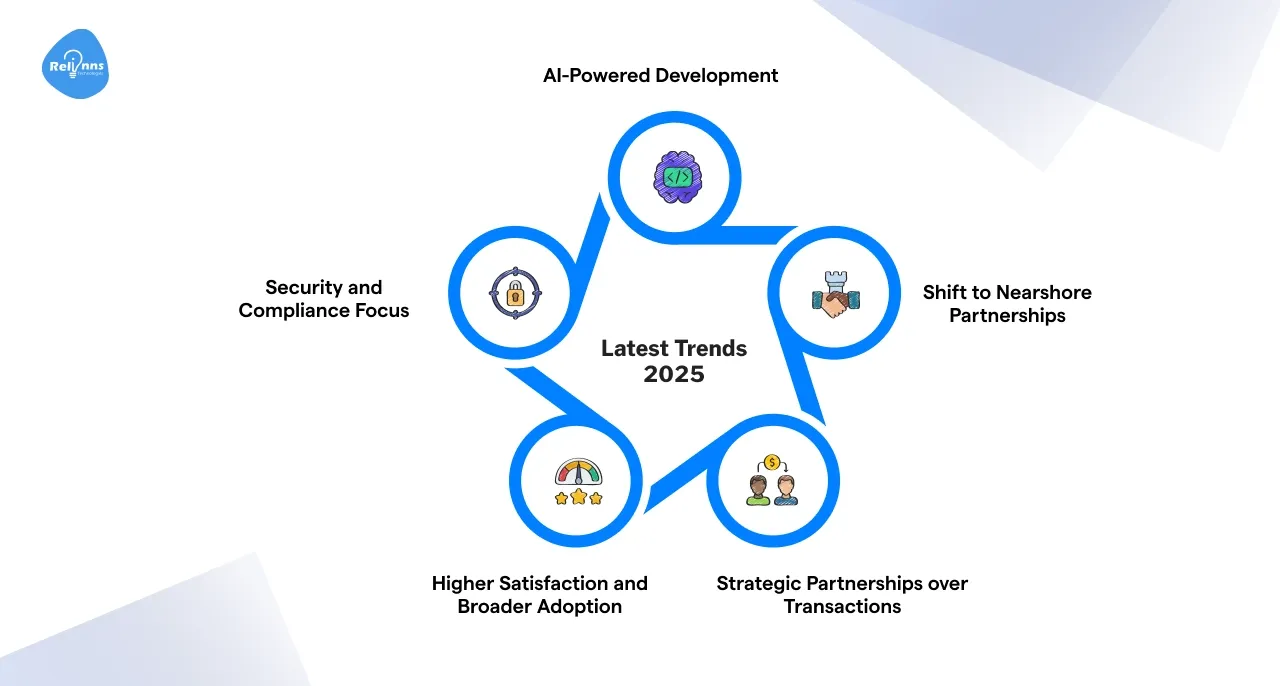
Outsource development is constantly evolving. As we move into 2025, several key trends in outsource software development are shaping the way companies and vendors collaborate.
Staying aware of these trends can help you outsource software development more effectively and capitalize on new opportunities. Here are some of the latest developments.
AI-powered development
- 65% of vendors now use AI extensively in application development processes.
- Adoption of AI boosts productivity in development by over 30% improvements.
- AI tools improve turnaround and enhance code quality in delivered projects.
- Automation through AI reduces manual testing and speeds defect detection cycles.
- Outsourcing partners leverage AI to streamline project management workflows.
Shift to nearshore partnerships
- 80% of companies now consider nearshore outsourcing for better collaboration.
- Time zone overlap enables smoother real-time communication and agile coordination.
- Cultural proximity reduces misunderstandings and enhances overall team synergy.
- Eastern Europe and Latin America are rising nearshore destinations in 2025.
- Nearshoring offers better alignment with internal processes and business hours.
Security and compliance focus
- Cybersecurity priorities are driving changes in outsource software development decisions.
- Vendors offer AI-driven monitoring and proactive threat detection frameworks.
- 2025 contracts often include data privacy and compliance enforcement clauses.
- Providers well-versed in GDPR and HIPAA gain greater trust from clients.
- Companies now bundle development and security under one outsourcing agreement.
Strategic Partnerships over Transactions
- 40% of CTOs call outsourcing essential, not just a cost-cutting tool.
- Companies seek long-term partnerships, not short-term project vendors.
- Cultural fit and aligned KPIs now influence vendor selection heavily.
- Outsourcing success depends on trust and shared business goals.
- Vendors are expected to contribute ideas, not just execute tasks.
Higher Satisfaction and Broader Adoption
- 78% of businesses report satisfaction with outsourcing outcomes and results.
- Companies see better quality and faster delivery through external teams.
- Outsourcing now includes AI, DevOps, and analytics beyond core development.
- Even risk-averse industries now delegate critical tech functions externally.
- The trend confirms that outsourcing will remain a standard innovation strategy in 2025.
By understanding these trends, companies can outsource software development in ways that leverage modern best practices and optimize their operations.
Whether it’s choosing a nearshore vendor for easier communication or ensuring your partner uses the latest AI tools, aligning with the direction of the industry will set your project up for success.
What are the best practices for outsourcing software development?
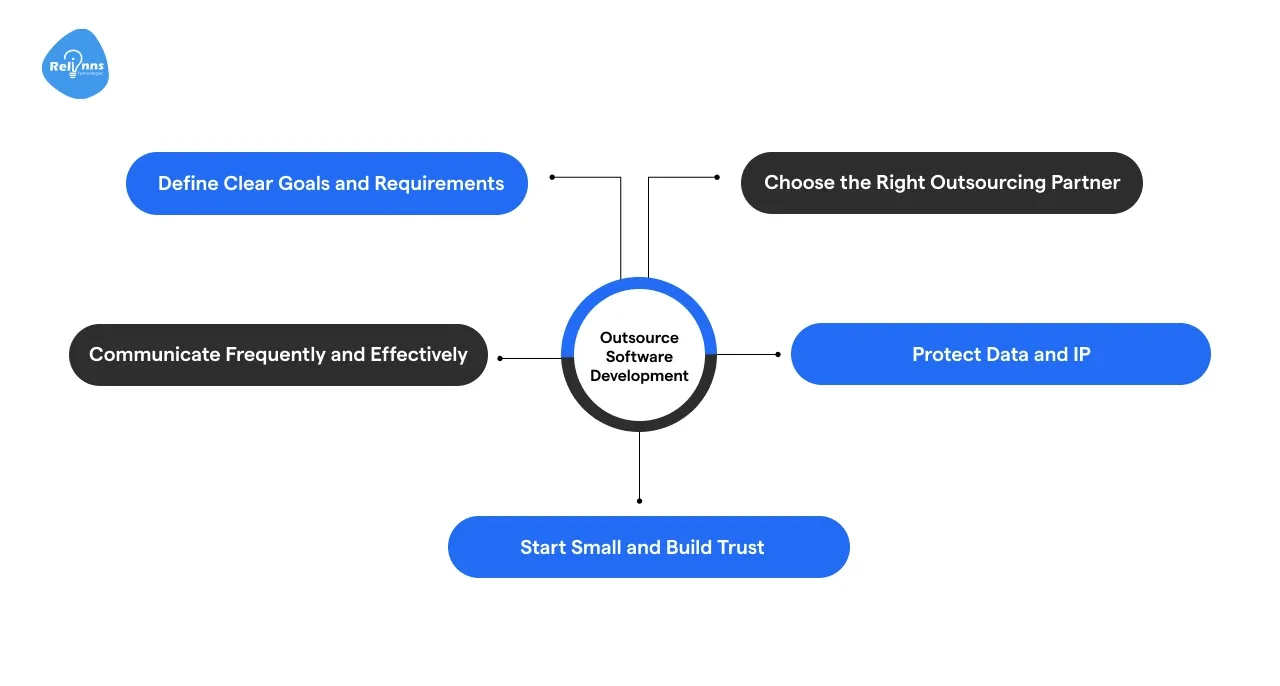
Embracing outsource software development can yield tremendous benefits, but it’s essential to approach it the right way. Poor execution or choosing the wrong partner can lead to disappointment.
Outsource development benefits can be maximized through these best practices.
Define clear goals and requirements
- 65% of project delays are due to unclear expectations – avoid this by starting strong.
- A detailed project brief outlining objectives and deliverables helps avoid ambiguity.
- Success metrics like deadlines and code quality should be aligned early.
- Avoid scope creep by maintaining clear documentation throughout development.
- Vendors work better when they understand your vision and priorities.
- Set expectations on timelines, features, and “what done looks like.”
Choose the right outsourcing Partner
- Not all outsourcing firms are equal – research is your safeguard.
- Evaluate technical expertise and relevant domain knowledge before shortlisting.
- Use Clutch and G2 to verify genuine client reviews and rankings.
- Request case studies or references to validate your experience.
- Ensure cultural compatibility and a proactive communication style.
- A solid partner selection process creates long-term project success.
Communicate frequently and effectively
- Communication gaps can derail even the best-laid development plans.
- Schedule regular check-ins (video calls, reports) to monitor progress.
- Ensure some time zone overlap to allow for real-time discussions.
- Use platforms like Slack, Trello, or Jira for transparency.
- Treat your outsourced team as an extension of your core team.
- Strong communication reduces delays and prevents rework.
Protect Data and IP
- Security is a non-negotiable when outsourcing software development.
- Always sign a Master Service Agreement with strong IP protection.
- Include NDA clauses to safeguard confidential information.
- Utilize vendors that adhere to secure coding practices and employ encrypted pipelines.
- Provide sanitized or limited-access datasets when needed.
- Partners experienced in GDPR and HIPAA compliance offer extra assurance.
Start Small and Build Trust
- Begin with a small scope to validate capabilities before committing large budgets.
- Pilot projects are perfect for testing collaboration and quality output.
- Provide frequent feedback and involvement during the initial stages of delivery.
- Once trust is built, you can scale the partnership confidently.
- Early collaboration helps shape a stronger long-term relationship.
Following these best practices will set the stage for a successful outsourcing engagement. In summary, plan thoroughly, choose your partner carefully, communicate effectively, and protect your interests.
When you do so, software development outsourcing can become a seamless extension of your business and a driver of superior results.
Conclusion
Software development outsourcing has evolved into a key strategy for companies seeking to innovate faster and operate more efficiently.
By now, it’s clear that outsourced development offers far more than labor cost arbitrage. It enables access to world-class talent, rapid scaling, and modern technologies that propel your business forward.
It's no wonder that 40% of CTOs view outsource software development as essential to their operations. When executed well, outsourced development becomes a long-term partnership that enhances your product development capabilities and strengthens your competitive position.
If you’re considering leaping, remember the best practices: choose your partner wisely, communicate openly, and align the work with your goals. With the right approach, outsourced development can deliver outstanding results and even become a seamless extension of your in-house team.
If you're looking to outsource software development services with a low-code platform like Joget, Relinns is the partner you can rely on.
Relinns offers expert Joget development services that enable rapid, secure, and cost-effective application deployment. From building workflow automation tools to enterprise-grade systems, Relinns delivers results that scale with your business needs.
Why choose Relinns for Joget development?
- Backed by a proven Joget portfolio, Relinns builds scalable business apps fast.
- Their developers use the best Joget practices for secure and efficient delivery.
- Get access to a dedicated Joget team through flexible outsourcing models.
- Relinns ensures workflow automation, saving time and reducing human errors with Joget.
- You receive constant support from a trusted software outsourcing leader in the market.
Partner with Relinns today and transform your business through robust, scalable Joget-driven solutions that accelerate growth and innovation.
Frequently Asked Questions (FAQs)
How to outsource software development projects?
To outsource software development projects, define your goals, choose the right engagement model, evaluate vendor expertise, ensure clear communication, sign contracts, and monitor progress for successful, cost-efficient delivery.
How much can I save with outsourcing?
Savings often vary significantly, typically ranging from 30% to 70%. However, actual outcomes can be influenced by various factors, such as effective communication, product quality, and management practices.
One of the most significant risks associated with outsourcing is poorly defined requirements. Approximately 70% of issues in outsourced projects arise from unclear or constantly evolving project specifications, which can lead to misunderstandings and project delays.
How to protect your intellectual property (IP)?
It's essential to use non-disclosure agreements (NDAs) to safeguard sensitive information, incorporate IP assignment clauses in contracts, and consider managing critical elements internally.
What is the difference between Fixed-price vs. time-and-materials contracts?
Fixed-price contracts are ideal for projects with clearly defined scopes and deliverables, while time-and-materials agreements provide the flexibility necessary to adapt to changing requirements.
Hybrid models that combine these approaches often yield optimal results for both project stability and adaptability.
How do I ensure quality offshore?
Ensuring quality in offshore software development begins with setting clear expectations from the outset. Define detailed technical requirements, acceptance criteria, and success metrics before the project's commencement. This gives offshore developers a solid roadmap to follow.
What is the ideal team size?
Research indicates that teams consisting of 5 to 9 developers generally achieve the highest effectiveness. For larger projects, it’s beneficial to break the work into smaller, specialized teams to ensure focus and productivity.



